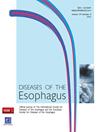536.从匹配的癌症类器官培养物中提取食管腺癌的肿瘤信息 "液体活检 "技术
IF 2.3
3区 医学
Q3 GASTROENTEROLOGY & HEPATOLOGY
引用次数: 0
摘要
背景食管腺癌(EAC)缺乏复发性突变,这给检测血浆中的循环肿瘤DNA(ctDNA)带来了挑战,并可能阻碍液体活检方法的发展。为了解决这个问题,我们培养了源自患者的EAC器官组织(PDOs),推测它们可以作为鉴定患者血液样本中ctDNA的指南。这种方法旨在利用有机体作为一种潜在的工具,克服鉴定 EAC 中 ctDNA 的复杂性,为完善临床实践中的液体活检策略提供了一种前景广阔的途径。方法 在 Matrigel 穹顶下从 EAC 肿瘤组织中生成 PDOs,并在悬浮培养中进行扩增。为了分离单核糖体(147 bp),从 PDO 提取染色质并用微球核酸酶(MNase)消化。通过大小选择去除大于 147 bp 的片段。对每个样本进行 MNase 测序,生成优先覆盖核糖体保护 DNA 的突变图谱。每个 PDO 样本的匹配肿瘤全基因组测序用作对照。针对核糖体保护 DNA 中已确定的突变设计引物,并用于扩增患者的 cfDNA 以进行测序。结果 收集五个不同 PDO 的 DNA 并进行 MNase 消化。对每个样本的 MNase 浓度和消化时间进行了优化。所有样本的 MNase 消化都产生了约 147 bp 的单核糖体。MNase 测序在 24 个基因(包括已知的致癌基因)的峰(单核糖体)中发现了 24 个突变。其中包括 16 个错义突变、2 个框移突变和 1 个无义突变,以及 5 个剪接区突变。迄今为止,利用总 PDO DNA 或正常无细胞 DNA 进行 PCR 扩增,已检测到 6 个基因的预期大小的扩增子,证实了这些基因的可检测性。使用患者 ctDNA 进行 PCR 扩增和下一代测序的工作正在进行中。结论 这些研究结果表明,我们能够从不同的 PDO 中分离并检测核糖体中的体细胞突变,从而为每个样本生成核糖体 SNV 图谱。初步数据表明,这些区域可以从正常的 cfDNA 中进行 PCR 扩增。从相应的患者血液 ctDNA 中扩增突变区域并进行序列验证的工作正在进行中。绘制患者特异性变异的图谱将有助于开发有针对性的个性化 PCR 图谱,帮助预测复发并提高药物筛选的准确性。这一进展有望通过弥补复发预测方面的不足,实现早期癌症检测并改善 EAC 患者的预后。本文章由计算机程序翻译,如有差异,请以英文原文为准。
536. TUMOR-INFORMED “LIQUID BIOPSY” FOR ESOPHAGEAL ADENOCARCINOMA FROM MATCHED CANCER ORGANOID CULTURE
Background The absence of recurrent mutations in esophageal adenocarcinoma (EAC) poses a challenge in detecting circulating tumor DNA (ctDNA) in plasma and may hinder the advancement of liquid biopsy methods. To address this, we cultured patient-derived EAC organoids (PDOs), speculating that they could serve as a guide for identifying ctDNA in the patient's blood samples. This approach aims to leverage organoids as a potential tool to overcome the complexity of identifying ctDNA in EAC, offering a promising avenue for refining liquid biopsy strategies in clinical practice. Methods PDOs were generated from EAC tumor tissue in Matrigel domes and expanded in suspension culture. To isolate mononucleosomes (147 bp), chromatin from PDOs was extracted and digested with micrococcal nuclease (MNase). Fragments larger than 147 bp were removed through size selection. MNase-sequencing was performed to generate a mutation map with preferential coverage of nucleosome-protected DNA for each sample. Matched whole genome sequencing of the tumor for each respective PDO sample was used as a control. Primers were designed for the identified mutations in nucleosome-protected DNA and used to amplify patient cfDNA for sequencing. Results DNA from five different PDOs were collected and MNase digested. MNase concentration and digestion time were optimized for each sample. MNase digestion produced mononucleosomes of approximately 147 bp for all samples. MNase-sequencing identified 24 mutations in peaks (mononucleosomes) in 24 genes, including known oncogenes. Among these were 16 missense, 2 frameshift, and 1 nonsense mutations, and 5 mutations in splice regions. To date, amplicons of expected size were detected by PCR for six genes using either total PDO DNA or normal cell-free DNA, confirming the detectability of these genes. PCR amplification using patient ctDNA and next-generation sequencing is ongoing. Conclusion These findings show that we are able to isolate and detect somatic mutations in nucleosomes from different PDOs, allowing us to generate a nucleosome SNV map for each sample. Preliminary data indicate these regions can be PCR amplified from normal cfDNA. Amplification and sequence verification of mutated regions from corresponding patient blood ctDNA is ongoing. The mapping of patient-specific variants will enable the development of targeted personalized PCR panels, aiding in recurrence prediction and enhancing drug screening accuracy. This advancement holds promise for early cancer detection and improving prognoses for individuals with EAC by addressing gaps in recurrence prediction.
求助全文
通过发布文献求助,成功后即可免费获取论文全文。
去求助
来源期刊

Diseases of the Esophagus
医学-胃肠肝病学
CiteScore
5.30
自引率
7.70%
发文量
568
审稿时长
6 months
期刊介绍:
Diseases of the Esophagus covers all aspects of the esophagus - etiology, investigation and diagnosis, and both medical and surgical treatment.
 求助内容:
求助内容: 应助结果提醒方式:
应助结果提醒方式:


